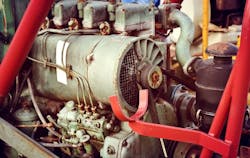Mark Gimson is business development and marketing manager for Singer Valve. Gimson can be reached at [email protected].
How to Adjust Water Pressure
If you are now the proud owner of a new pressure reducing valve or have just taken over a system that might have them installed—or you are just bringing one back online that has been out of service for repairs—then this checklist is for you.
You will need the following tools:
- Screwdriver;
- Two adjustable wrenches; and
- Two pressure gauges (ideally these will already be installed in the valve chamber).
If the chamber is underground, confined space entry regulations also may need to be followed, but that is beyond the scope of these instructions.
Before you begin, there are just a couple of items that need clarification. First, in order to set up a reducing valve, you are going to need flow. In a brand-new installation, this can be achieved by opening a fire hydrant downstream. Be careful not to have this discharging all over new landscaping, or you will face the wrath of the developer. Second, it is always better to start at a lower pressure and bring the pressure up to your desired set point than it is to start higher. Before you begin, check the system pressure upstream of the valve and what you require downstream after the reducing valve. Adjust water pressure as needed.
With these points in mind, it is time to start.
Step 1: Isolating Valve
Ensure that the downstream isolating valve on the main line where the reducing valve is located is closed.
Step 2: Pressure Gauge
Install a pressure gauge upstream and downstream of the reducing valve. The upstream gauge is not critical, whereas the downstream gauge is if you want to set the valve accurately.
Step 3: ‘Open’ Position
Open the inlet isolating valve to allow the reducing valve to fill with water. Ensure that all of the ball valves on the pilot system are in the “open” position.
Step 4: Pilot System Strainer
If the main line has been flushed, this might be a good time to check the pilot system strainer. This will have a blowdown plug installed, which, if removed, will allow water to flow out of the strainer. Just ensure that this strainer is clean and water flows freely. If not, take out bushing and remove the screen and clean. The strainer is a very important part of the pilot system and will need periodic cleaning in the future.
Step 5: Trapped Air
The valve and pilot system need to be vented of any trapped air. If not, this will cause issues with the readings, as air is compressible. Air can be removed either by venting out of the position indicator bleed screw (if installed) or by slightly loosening one of the flare fittings at the highest point in the pilot system. Do not loosen completely—just enough to bleed air and eventually a small stream of water. Bleed until the water runs clear.
Step 6: Pilot Setting
Check the pilot tag setting to determine if the pilot has been pre-set. Reducing pilots typically are adjusted with a set screw in the top of the spring casing, and turning clockwise will increase the downstream pressure setting. If the pilot has not been set and you have no idea what the setting could be, it is better to back off the adjustment screw, as this means the pilot setting is now decreasing. If the screw is adjusted all the way out, the pilot setting now is at the lowest point on the spring range. For example, with a 20- to 200-psi pilot spring range, this would be the 20-psi setting. If the screw is all the way in, then the set point would be 200 psi. The adjustment screw will have a locknut that will require loosening to make any adjustments.
Step 7: Pressure Reducing Valve Adjustment
With the adjustment screw in a position you feel comfortable with, open the main line downstream isolating valve. This does not have to be fully open, but enough that you can hear flow and the pressure reducing valve starting to open.
Step 8: Cavitation
As the reducing valve opens, it may be noisy, as you have the pilot set very low (if the screw is backed out), and so the valve will be trying to throttle down to a very low pressure. It also may be cavitating at this point, which would not be ideal for a long-term set point but is fine for a few minutes.
Step 9: Pressure Setting
While checking the downstream pressure gauge, start adjusting the pilot clockwise to increase the pressure setting for pressure reducing valve adjustments. Do this slowly, as it will take a few seconds for the system to stabilize. You will reach a point where you will see that, as you make an adjustment on the screw, the gauge will track your movements as you adjust water pressure.
Step 10: Set Point
Once you have the gauge reading the pressure you require (we always recommend taking the set point a couple of psi higher than the desired set point), bring it a couple of psi below the required set point; then slowly bring up to the set point and tighten the locknut to lock in that setting.
At this point, the valve is set. The downstream isolating valve can be opened fully and the fire hydrant (if used) can be closed.
The only other possible adjustment that may be required would be the speed control (if installed) and, in a typical reducing valve, this would be an opening speed control.
The opening speed of the valve can be checked by observing the valve when it is in the open position—this is where a position indicator always is useful. Close the ball valve installed between the reducing pilot and the main body outlet. This will force the main valve to close.
Once fully closed, open this ball valve and determine how quickly the main valve opens. You never want a reducing valve to open too quickly, as this could cause downstream surges. If it does open too fast, then the speed control can be adjusted. See the valve owner’s manual for instructions. On a Singer Valve, this would be the Model 26 Speed Control and requires a screwdriver for adjustment. This control also is useful for eliminating “hunting” at low flows.
If you now have a working reducing valve, congratulations! If for some reason (Murphy’s Law) it did not go as smoothly as it should have, then it is time to consult troubleshooting charts or discuss it with your control valve supplier.
Download: Here



